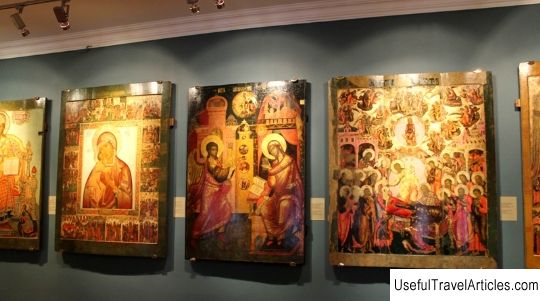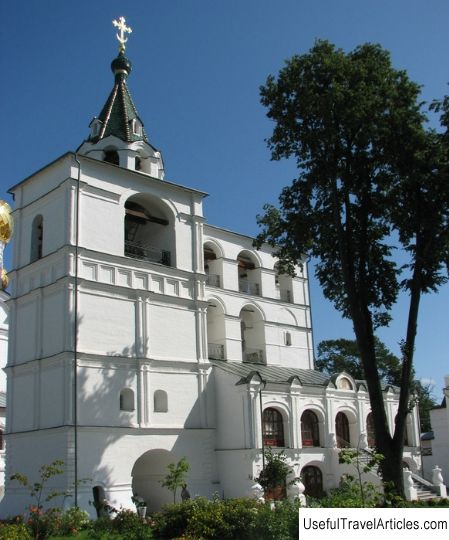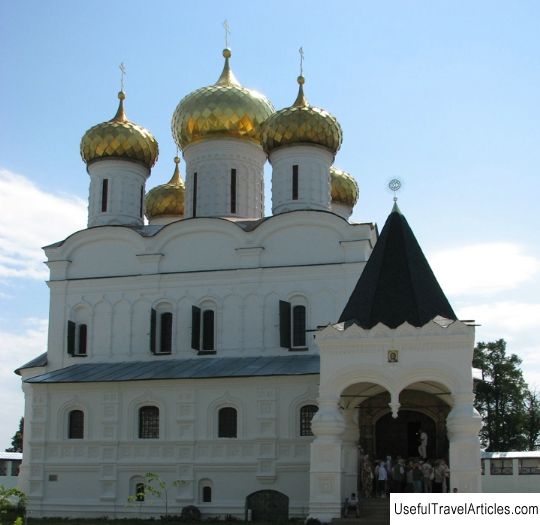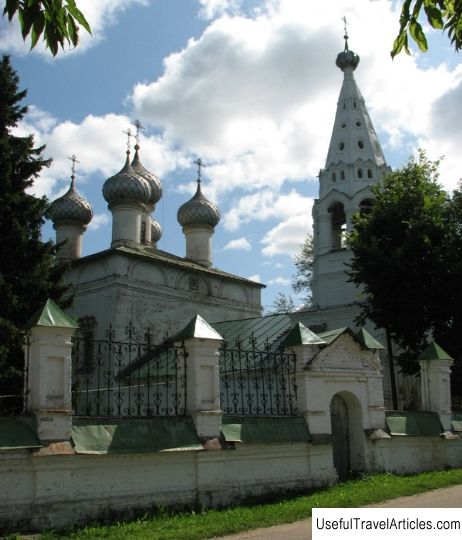Ipatiev Monastery description and photos - Russia - Golden Ring: Kostroma
Rating: 7,9/10 (121 votes) 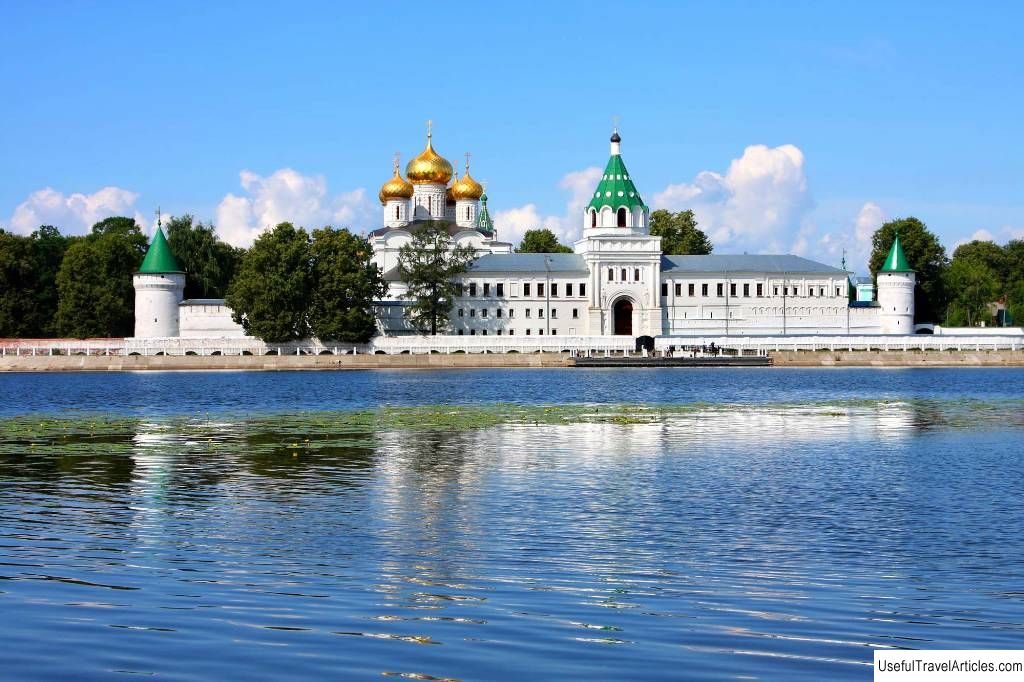
Ipatiev Monastery description and photos - Russia - Golden Ring: Kostroma. Detailed information about the attraction. Description, photos and a map showing the nearest significant objects. Photo and descriptionThe Ipatiev Monastery in Kostroma is a historical place. It was here in 1613 that young Mikhail Romanov gave his consent to rule the state, from which the 300-year rule of the Romanov dynasty began. Now there is a unique church museum and a functioning monastery. History of the monasteryTradition says that the monastery was founded in 1330 by a Tatar murza named Chet - the distant who converted to Russian service and converted to Orthodoxy ancestor of Boris Godunov. Perhaps the monastery was here before, it is just that Chet made a rich contribution to it, but the monastery became the burial vault of his descendants - Saburovs and Godunovs . The necropolis once numbered 53 burials of members of these families, some of which have survived to our time. The monastery was small, the stone Trinity Cathedral appeared in it only in 1560 - before that all buildings were wooden. At the end of the 16th century, with the rise of the Godunovs and then the Romanovs, active construction began. The monastery is surrounded by walls, over the main entrance there is a gate church of St. Theodore Stratilates and St. Irina - the patrons of Tsar Fyodor Ioannovich and Tsarina Irina. The walls themselves are more than five hundred meters around the perimeter, about one and a half meters thick and seven meters high. It is a classic 16th-century fortress: with towers built for cannons, a powder store and even a secret passage to the river. In 1608-1609, the fortress had to defend itself - it was captured by the troops of False Dmitry II, and the Galich people's militia fought off the fortress, blowing up part of the wall. And in 1632 the monastery finds itself at the very center of politics. A 16-year-old Mikhail Romanov is elected to the kingdom and the embassy with this message goes to Kostroma - he lives just here, in one of his estates, in Domnino. The famous feat of Ivan Susanin refers to this very moment in history. The Polish-Lithuanian detachment is trying to find the young tsar, looking for a way to Domnino, but the headman Ivan Susanin leads them into the swamp, and not to the tsar. The meeting of the embassy and the Romanov family takes place just at the walls of the Ipatiev Monastery. Mikhail Romanov and his mother, nun Martha, have to be persuaded to accept this burden, but in the end Mikhail agrees. In the 17th century, the monastery was under the patronage of the Romanov family. Here the walls damaged in 1609 are being rebuilt, the territory is almost doubled, a new church is being built - John Chrysostom. In 1652, the Trinity Cathedral was rebuilt (the previous one was badly damaged due to the explosion of powder stores in the basements), and thirty years later it was painted by the famous artel of Guria Nikitin. In the 18th century, the monastery became poorer, but continues to be built - now it is the center of the Kostroma diocese and the bishop's residence. In the basements of the Trinity Cathedral, a temple is being built. St. Lazarus - the burial vault of bishops, the Theological Seminary was formed, the rector's chambers were rebuilt - now the Kostroma bishops live here. In 1834 Nicholas I came here. During these years he was involved in the preservation of the historical heritage a lot, so by his order the monastery was being renovated under the guidance of the most famous architect of that time - Konstantin Ton. According to his project, the Royal Chambers, the rector's and bishops' buildings are being rebuilt, new gates are being built. In 1913, the 300th anniversary of the Romanovs' house is magnificently celebrated here. After the revolution, the monastery was closed, the main values were confiscated, some of the premises were transferred to the museum, and some were used for housing. But since 1958 the entire territory of the monastery has become a museum. Some monuments of wooden architecture are being transported here and a museum-reserve is being set up. Now he has moved and is located not far from the walls of the Ipatiev Monastery. Since 1992, monastery life has been reviving. What to see The fortress was built in 1586-90 . five towers of this time have survived, three towers built in the middle of the 16th century during the expansion of the monastery on the model of the old ones, and three entrance gates. The main Catherine's Gate in the Baroque style, built in 1767 for the arrival of the Empress. Above them is the monogram of Catherine II. The Holy Gates with the gateway church of Chrysanthus and Daria were built in the middle of the 19th century according to the project of K. Ton. The dedication of the church is connected with the fact that it was on the day of these saints that Mikhail Romanov left Kostroma for Moscow to reign, and many years later, on this very day, Russian troops entered Paris. And finally, the western gate now connects two parts of the monastery territory - the old, Godunovskaya, and the new, built under Mikhail Romanov. Trinity Cathedral the monastery was built in 1650-1652. It is a five-domed, four-pillar temple with a front porch and rich carvings. Inside, there are 17th century frescoes by Guriy Nikitin's team, and a baroque five-tiered iconostasis of the 18th century. The murals of the gallery-porch were made in 1912. It is worth paying attention to Tsarskoe mesto - a carved wooden canopy, sent here by Mikhail Romanov already from Moscow. It was dismantled, then reassembled for the visit of Catherine II and has been in the cathedral ever since. The doors of the temple are preserved from the previous building, they were made in the 15th century. The copy from the Tikhvin Icon of the Mother of God of the 18th century, located here, is revered as miraculous. It was once richly decorated. After the revolution, the salary was lost, but already in the 21st century, when the icon was returned to the monastery, a new one was made for it, no less rich and beautiful. In the basement of the monastery are the remains of the Godunovs' tomb. The Bell Tower was built at the end of the 16th century and was rebuilt in the middle of the 17th and 19th centuries. Now there is an observation deck on it and you can climb there. In addition to churches, the monastery has several other living quarters. These are richly decorated viceroy and bishop buildings , built in the 16th century and renovated in the 19th, simpler Brothers building , household buildings. Among them we can distinguish “ Cells above the cellars "- a building built over three-meter glacier cellars, Refectory of the 16th century, where the kitchen was located, and the Candle Factory of the 19th century. Memorial column , erected by Nicholas I in 1839. It contains texts describing the historical events that took place in the Ipatiev Monastery. Now at the column there are regular prayers to the royal family. The Romanov Chambers . - the building itself was built in the 16th century for the Godunovs who often stayed at the monastery, and in 1613, when he was elected to the kingdom, young Mikhail Romanov lived here with his mother. It was repaired in the 30s of the XIX century by the project of K. Ton, and then again in the 60s by the project of F. Richter. F. Richter is responsible for the "chess" painting of the walls and the restoration of historical tiled stoves. Since the 1830s, a room has appeared in the Chambers of the Romanovs, where portraits of the reigning persons are located, and since 1863 it is precisely a small museum, where not only portraits, but also relics are located - for example, the staff of Mikhail Romanov. Now the building is still a memorial and these relics are kept in it: the staff of Mikhail Romanov, a copy of the Fedorov icon, which his mother Martha blessed him with the kingdom, a lifetime portrait of Mikhail Romanov, the autograph of Nicholas II left here in 1913 and much more. . Museum Since 1912 to the basis of the monastery sacristy was opened Ancient storage , where they brought antiques from all over the Kostroma province. Since 2004, the Church Historical and Archaeological Museum has been operating here. Despite the fact that it is subordinate to the church, it is a full-fledged museum - it cooperates with state museums, arranges exhibitions. The basis of the museum's collection is jewelry from the Ancient Depository and the monastery sacristy. These are objects of decorative and applied art, which are contributions to the monastery from the ruling persons - Boris Godunov and the Romanov family - and simply collected from different temples of the province. These are icons, church utensils, books, details of the church interior - the royal gates, richly embroidered vestments, shroud and air, mitres, carved wooden icons and details of iconostases. the most important part of which is The Tale of Bygone Years, the oldest document on Russian history. It was found in 1814 in the monastery library by the historian N. Karamzin.                       We also recommend reading Art Museum description and photos - Finland: Imatra Topic: Ipatiev Monastery description and photos - Russia - Golden Ring: Kostroma. |
